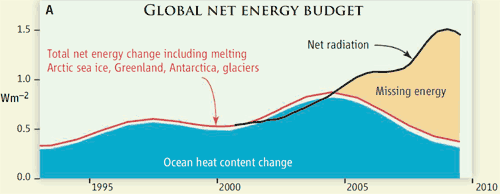Tracking the energy from global warming
Posted on 18 April 2010 by John Cook
The most striking feature of Climategate is how readily people assumed dark, sinister conspiracies from isolated email quotes without trying to understand the actual science being discussed. This is apparent in the "hide the decline" quote which many took (and continue to take) to mean a nefarious hiding of a decline in temperature. What it actually refered to was a decline in tree-ring growth that has been openly discussed in the peer-reviewed literature since 1995. Similarly, Trenberth's "travesty that we can't account for the lack of warming" was an issue openly discussed in the peer-reviewed literature (Trenberth 2009). The issue of Trenberth's missing heat is now further discussed in a new Science perspective by Trenberth and John Fasullo, "Tracking Earth's Energy".
The article examines the planet's energy imbalance. This can be measured by satellites which measure both the incoming sunlight and outgoing radiation. The absolute energy imbalance is too small to be measured directly. However, the satellite measurements are sufficiently stable from one year to the next so it's possible to track changes in the net radiation. What has been observed is an increasing energy imbalance.
Another way to calculate the energy imbalance is to add up all the heat accumulating in the various parts of our climate. This includes all the heat building in the oceans, warming of the land and atmosphere, melting of the Arctic sea ice, Greenland and Antarctic ice sheets and glaciers. There is fairly good agreement between the satellite imbalance and total heat content leading up to 2005. However after 2005, there is a discrepancy between the two metrics. A divergence problem, if you will.

Figure 1: Estimated rates of change of global energy. The curves are heavily smoothed. From 1992 to 2003, the decadal ocean heat content changes (blue), along with the contributions from melting glaciers, ice sheets, and sea ice and small contributions from land and atmosphere warming, suggest a total warming (red) for the planet of 0.6 ± 0.2 W/m2 (95% error bars). After 2000, observations from the top of the atmosphere ( 9) (black, referenced to the 2000 values) increasingly diverge from the observed total warming (red).
Figure 1 has many interesting features. The blue area shows the rate of ocean warming. Note that when it falls after 2005, this doesn't mean the ocean is cooling but that the rate of warming slows. The red line is the total amount of net energy change. This means that all the energy going into the melting of sea ice, ice sheets and glaciers plus the warming of land and atmosphere is the tiny gap between the blue area and the red line. However, the most interesting feature of this graph is the divergence after 2005. From this point, the satellite data (black line) continues to show a growing energy imbalance. But the ocean seems to be accumulating less heat.
Why the discrepancy? Some of the heat seems to be going into melting the ice sheets in Greenland and Antarctica which are losing ice mass at an accelerating rate. However, this doesn't add up to anywhere near the measured energy difference. There are two possibilities. Either the satellite observations are incorrect or the heat is penetrating into regions that are not adequately measured. The satellite observations also agree with model results that expect a growing energy imbalance as CO2 levels increase. These model results have had quantitative confirmation in independent satellite measurements of outgoing infrared spectrum (Harries 2001, Griggs 2004, Chen 2007).
This would indicate the missing heat is the more likely option. If so, where has the missing heat gone? Is the ocean sequestering heat deep below where the ARGO buoys measure water temperature? I had my own Dunning-Kruger moment after reading this paper. My theory was we already had observational proof that the heat must be sequestered in the deep ocean waters. While measurements of ocean heat going down to 700 metres have showed declining heat accumulation, von Schuckmann 2009 shows that measurements of ocean heat going down to 2000 metres find the oceans have been steadily accumulating heat at 0.77 W/m2 from 2003 to 2008.

Figure 2: Time series of global mean heat storage (0–2000 m), measured in 108 Joules per square metre.
I emailed Kevin Trenberth, asking if von Schuckmann's result was evidence that the missing heat was being sequestered in deeper waters. Trenberth replied promptly (the guy is a class act), informing me that von Schuckmann's energy imbalance of 0.77 W/m2 was for the ocean only and when you average it out over the whole globe, it gives a net energy imbalance of 0.54 W/m2. This is still insufficient to meet up with the satellite data and there are unresolved issues with how von Schuckmann handles the deep water heating.
In fact, after reading Roger Pielke's blow-by-blow with Trenberth, I have to credit Trenberth for his patience - I wonder how many bloggers contact him each day, saying "Hey Kevin, you heard of this paper?!" or "Hey Kevin, did it ever occur to you that the heat is in the deep ocean?!" Hopefully, Trenberth won't get bothered too much by nagging bloggers such as myself and he can get on with the important work of better tracking the flow of energy through our climate.































 Arguments
Arguments































Note that this refers to ocean heat from 0 to 700 metres deep. The issue here is the ocean heat measurements at deeper levels - both down to 2000 metres for which there is ARGO data and deeper, for which the data is more sparse. Figure 5.4 is even more interesting (in fact, has inspired an idea for a nifty graphic and a blog post), so here it is:
So one Sverdrup is equivalent to 30 million cubic metres per second. Hmm, I wonder how big that much water would compare to the Empire State Building...